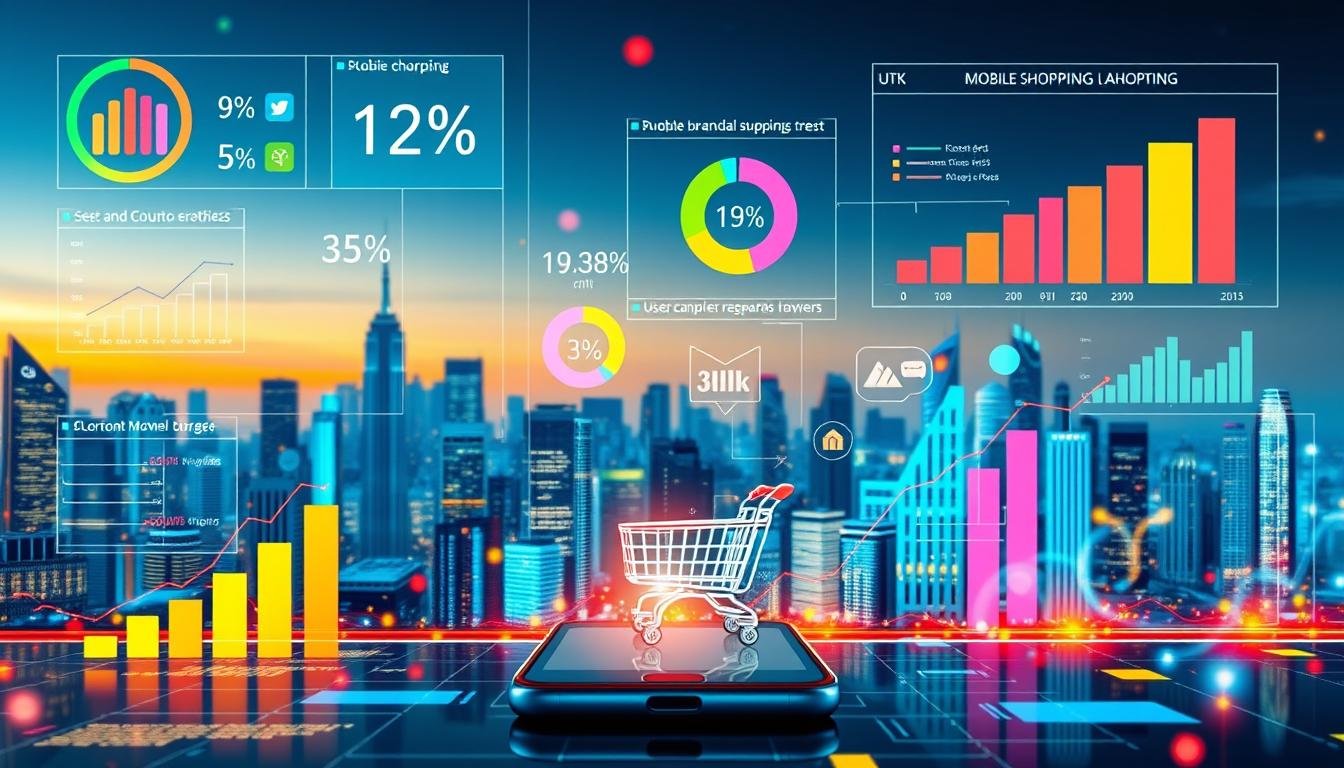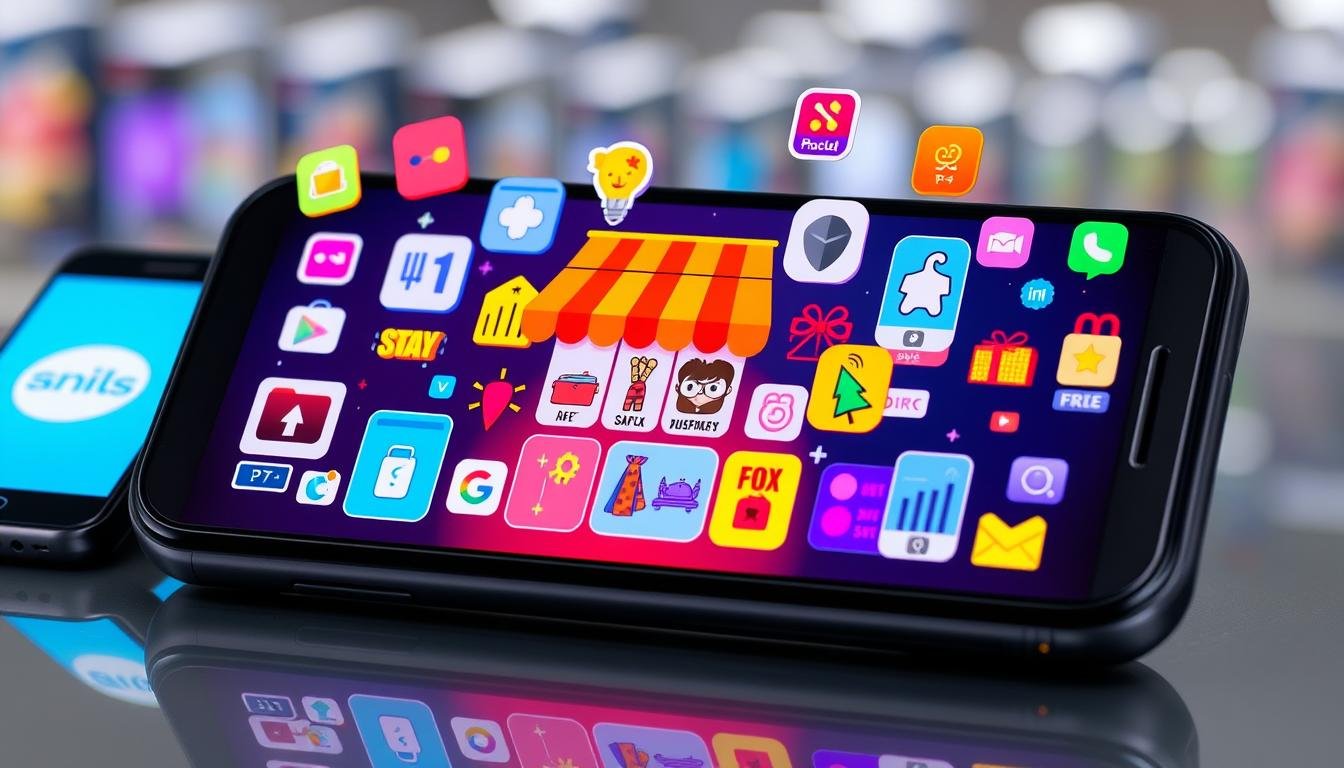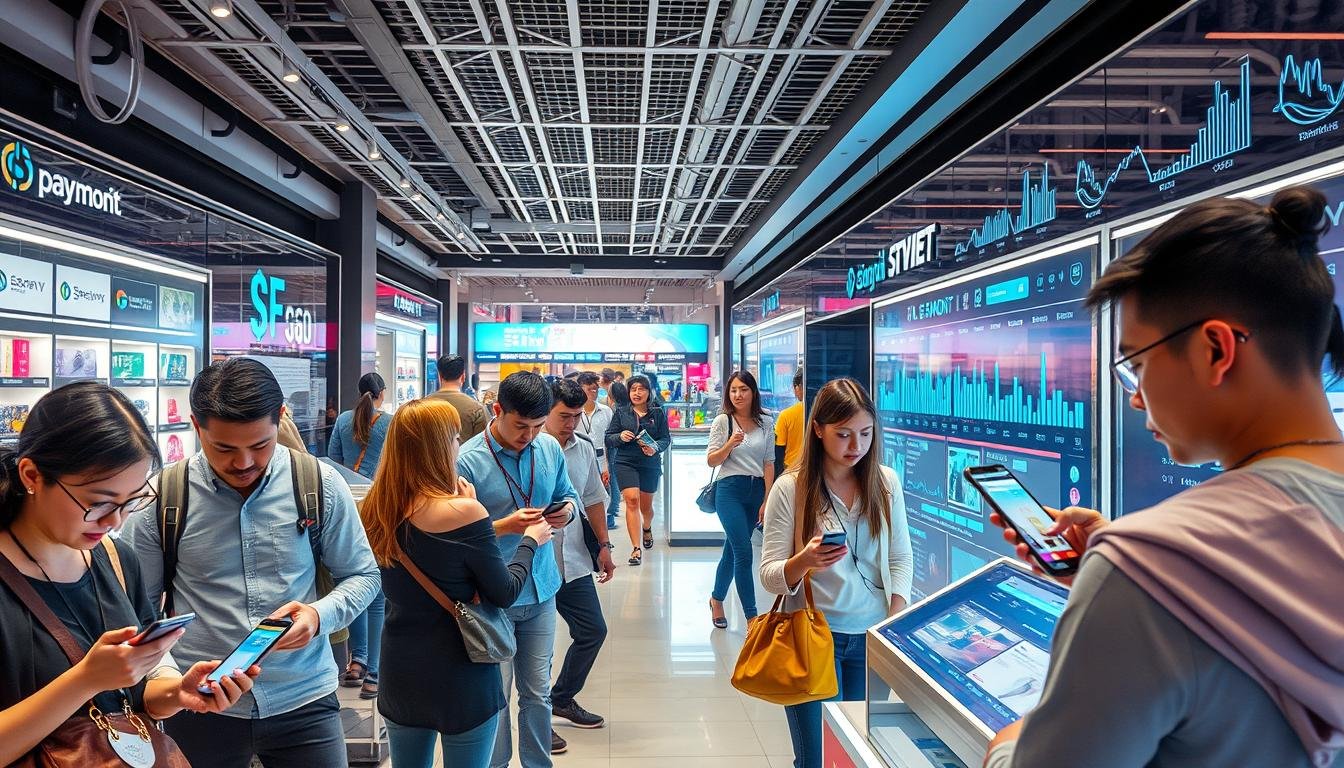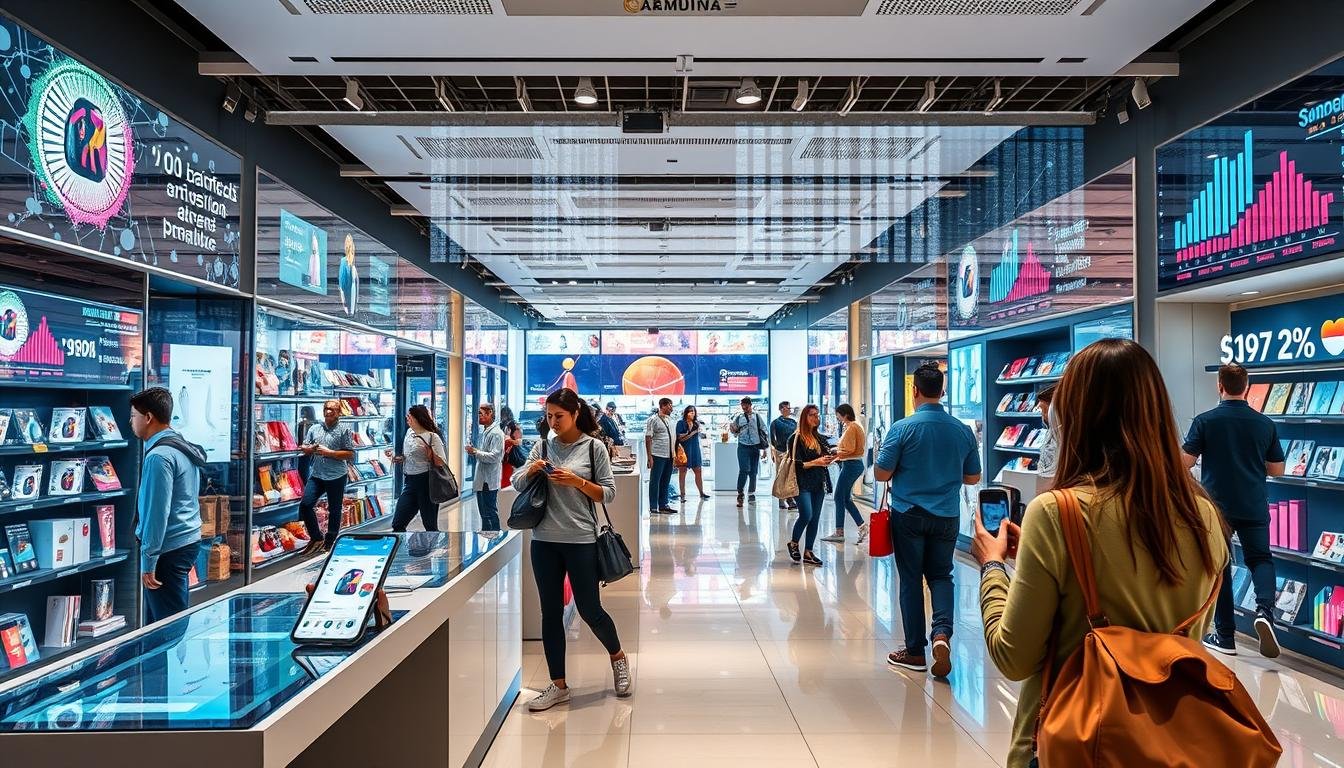Revealing Mobile Shopping Trends: What the Numbers Tell Us

Ever thought how big a role your smartphone plays in shopping? With mobile shopping statistics soaring, it’s key to grasp the power of mobile retail trends. This shift is most noticeable among the younger crowd.
A recent poll shows over 60% of US adults see mobile shopping as a must. This is huge, as retail mcommerce sales are set to hit $542.73 billion in 2024. This accounts for 7.4% of all retail sales, showing a big change in smartphone shopping behavior.
As we dive into mobile shopping, we’ll see what these trends mean for the future. You’ll learn how your shopping habits fit into this changing world.
Key Takeaways
- Over 60% of US adults view mobile shopping as essential for convenience.
- Retail mcommerce sales in the US are expected to reach $542.73 billion in 2024.
- Mcommerce is estimated to constitute 44.6% of total US retail ecommerce sales.
- Young adults are leading the charge in embracing smartphone shopping behavior.
- Mobile wallets are forecasted to dominate over 54% of all online payment transactions by 2026.
Understanding the Rise of Mobile Shopping
Mobile shopping habits have changed a lot. Smartphones are now key to our daily lives. Over 70% of online shopping happens on mobile devices, marking the start of the mobile commerce era.
As I watch how shopping habits evolve, it’s clear that mobile is changing retail. Mobile features are now a big part of how we shop.
The Evolution of Shopping Habits
More people are using mobile for shopping. In 2023, mobile commerce hit $2.2 trillion worldwide, making up 60% of all e-commerce sales. This shows a big shift towards convenience in shopping.
By 2027, mobile commerce is expected to make up 62% of e-commerce. This shows how fast this market is growing.
Key Factors Driving Mobile Shopping Growth
Several key factors are driving mobile commerce forward. Better mobile payment options like Google Pay and Apple Pay make buying easier. This leads to more people shopping on their phones.
Social media also plays a big role in mobile shopping. It makes buying things online easy and fun. Automation in billing and order processing also helps retailers stay competitive.
Mobile Shopping Statistics at a Glance
Understanding mobile shopping stats is key for anyone in eCommerce. The growth is not just in the U.S. but worldwide. Key trends from mobile data analysis show how they affect both retailers and shoppers. Here are some important data points to know:
Essential Data Points You Should Know
- Mobile traffic makes up over 60% of all website visits.
- More than 70% of eCommerce traffic comes from mobile devices.
- In the 2023 holiday season, online spending hit $241 billion, a 9% jump from the year before.
- eCommerce now makes up 15% of total retail sales.
- 84% of American homes have smartphones, with over 300 million users in the U.S.
- 79% of smartphone users bought something online in the last six months.
- 34% of shoppers buy online at least once a week.
- 40% of users will go to competitors if they have a bad mobile experience.
Global Comparisons and Trends
Looking at the mobile shopping world, global growth is strong. The U.S. has about 288.45 million online shoppers. China leads with around 904.6 million. By 2025, worldwide eCommerce sales are expected to hit $6.86 trillion, up 8.37% from 2024.
| Statistic | Value |
|---|---|
| Mobile traffic percentage of total website traffic | 60% |
| Mobile eCommerce sales percentage | 44.6% |
| U.S. consumers’ online spending during holiday season 2023 | $241 billion |
| Average time spent on mobile by U.S. adults | 31.7% |
These stats show a big change in how people shop online. They highlight the need to make online shopping better on mobile. Keeping up with mobile shopping data helps retailers stay ahead.
Age Demographics and Mobile Shopping
Smartphone shopping habits change with age. Young adults and seniors are now more into mobile shopping. This shows how different groups use mobile commerce. Knowing this helps us understand the mobile shopping market better.
Young Adults: Leading the Charge
Young adults, aged 25 to 34, lead in mobile shopping. They make up about 90% of mobile users. They love buying fashion and electronics online, wanting easy and quick shopping.
Elders Embracing Mobile Commerce
Older adults are also getting into mobile shopping. Almost 62% of those over 55 are now shopping online. They value simple and secure transactions. This shows a big change in how they use technology.
Popular Mobile Shopping Platforms
In today’s fast world, mobile shopping has changed how we buy things. I often think about the benefits of apps versus mobile websites. Choosing the right platform can make shopping easier and get me better deals.
App vs. Mobile Web: Which is Better?
The choice between apps and websites depends on user experience and what they offer. Studies show apps can lead to sales three times more than websites. This is because apps offer:
- Streamlined functionalities for mobile users.
- Access to personalized promotions and rewards.
- Real-time inventory updates for a better shopping experience.
- Higher average order values, showing better customer engagement.
With most people owning smartphones, apps are the best for mobile shopping. A good app can solve common problems, like small page layouts on websites.
Top Apps for an Enhanced Shopping Experience
Some apps stand out for their features and easy use. Apps like Amazon, Walmart, and Target are great for mobile shoppers. They make buying things easy and fun.
| App | Key Features | Average User Rating |
|---|---|---|
| Amazon | One-click purchasing, personalized recommendations | 4.8/5 |
| Walmart | Easy price comparison, shopping lists | 4.7/5 |
| Target | Loyalty rewards, same-day delivery | 4.6/5 |
Exploring these mobile shopping platforms can make buying things from my phone easier. As mobile shopping grows, keeping up with the best apps will improve my shopping experience.

The Impact of Social Media on Mobile Shopping
Social media is changing how we shop. I often see things I want to buy because of what my favorite creators share. This change makes shopping on our phones easier and more fun.
How Platforms Influence Consumer Behavior
Social media shapes what we buy. A big number of people—30%—buy things after seeing influencer posts. This is even more true for young people.
For example, 41% of adults under 30 and 50% of women in that group buy things after seeing influencer posts. These numbers show how shopping habits are changing.
Social Media Advertising Success Rates
Social media ads can be very effective. They have an average conversion rate of 4%. This shows that good content can really get people to act.
As more people shop on their phones, social media ads are getting a big share of that market. By 2025, 40% of mobile e-commerce will happen through social media.
Understanding how social media affects our shopping habits is key for both businesses and consumers.
Mobile Payment Trends Reshaping Retail
Mobile payment trends are changing retail in big ways. More people are using mobile wallets for their transactions. This is because these digital payments are fast and easy, appealing to the younger crowd.
Adoption Rates for Mobile Wallets
There’s been a big jump in mobile wallet use. Soon, nearly two-thirds of U.S. smartphone users will use mobile wallets for monthly buys. The global digital wallet market is set to hit $7.6 trillion by 2024. This growth is driven by more smartphones and the rise of contactless payments during the pandemic.
Security Concerns with Mobile Payments
Security is a big worry with mobile payments. Many people are cautious because of fears of identity theft and fraud. To win trust, retailers need to focus on strong security. New tech like tokenization and biometric authentication is helping make payments safer.

| Payment Method | Adoption Rate (%) | Projected Growth (2024) |
|---|---|---|
| Mobile Wallets | 66 | $7.6 trillion |
| Buy Now, Pay Later | High | Flexible options |
| Digital Euro | Anticipated | Available by 2028 |
The world of mobile payments is changing fast. By embracing these trends, retailers can improve customer experiences and tackle security issues head-on.
Challenges Faced by Mobile Shoppers
Mobile shopping has changed how we shop online. It’s easy to buy things on our phones, but there are problems. We need to fix these issues to help mobile shopping grow.
Navigating App Security and Privacy
More people are shopping on their phones, but they worry about safety. They fear their personal info might get stolen. Stores need to make their apps safe and clear about how they use our data.
This will help people trust mobile shopping more. It will make them more likely to shop on their phones.
The Role of Site Optimization in User Experience
It’s important to make mobile sites easy to use. Bad sites make people leave quickly. They don’t want to shop there anymore.
Most mobile shoppers think sites and apps can be better. If sites are fast and easy to use, people will shop more. It makes the whole shopping experience better.
| Challenges | Impact on Mobile Shopping | Solutions |
|---|---|---|
| Security Concerns | Decreased user trust and engagement | Implement strong security measures and transparent privacy policies |
| Poor Site Optimization | High bounce and cart abandonment rates | Enhance website performance and user experience |
| Integration Issues | Challenges in combining marketing and IT | Foster collaboration between teams to streamline efforts |
The Future of Mobile Shopping
The mobile retail world is set to grow a lot. Mobile commerce already makes up over 43% of all online sales. It’s expected to reach 44% by 2025. Knowing these trends helps businesses stay ahead of the game.
Predictions for the Next Five Years
Mobile shopping in the U.S. is expected to hit $542.73 billion by 2024. Mobile app orders average $102, while mobile websites average $92. About 85% of shoppers now choose apps for buying things.
This shows a big move towards using phones for shopping. People are getting better at buying things on their smartphones.
Innovations Shaping the Landscape
New things like augmented reality and voice shopping are changing how we shop on mobile. Buy Now, Pay Later services are becoming popular, making shopping easier. Mobile wallets and tap-to-pay systems are also growing, thanks to people wanting fast and safe payments.

| Year | U.S. Retail m-Commerce Sales (in Billion) | % of Total eCommerce Sales | % Utilizing Mobile Apps for Purchases |
|---|---|---|---|
| 2023 | $491 | 43% | 85% |
| 2024 | $542.73 | 44% | 50% (projected) |
| 2025 | $558 | 7.4% of retail sales | 60% (projected) |
Keeping up with mobile shopping trends is key. As shopping habits change, businesses need to adapt to stay successful.
Case Studies: Brands Excelling in Mobile Commerce
The mobile shopping world is changing fast. Some brands are leading the way with new strategies. Target and Amazon are at the top by matching their offers with what mobile shoppers want. Let’s look at how they use these trends to their advantage.
Target’s Strong Mobile Strategy
Target uses cloud technology in its mobile app. It gives users real-time inventory updates. This makes shopping easy and boosts customer happiness.
Mobile apps are better than websites for shopping. Target’s app shows this with a 157% higher conversion rate. It shows how well Target meets shopper needs, making shopping easy and quick.
Amazon’s Dominance in Mobile Shopping
Amazon is a big name in mobile shopping. Its app is easy to use and has lots of products. This has helped it get a big share of the market.
Amazon’s success comes from good prices and personalized suggestions. It uses AI to make shopping better for each user. This makes Amazon a favorite for many mobile shoppers.
Conclusion: Key Takeaways from Mobile Shopping Statistics
The rise of mobile shopping is changing how we shop. Over 50% of all web traffic now comes from mobile devices. This shows how smartphones have become key for online shopping.
By 2024, mobile shopping could make up nearly half of all e-commerce sales in the U.S. This highlights the need for businesses to focus on mobile strategies. They must meet the changing needs of their customers.
Summary of Trends
Almost all demographics are using smartphones for shopping. 97.6% of internet users aged 16-24 own a smartphone. Despite lower conversion rates, mobile apps are more popular, taking up more time than mobile web browsing.
As we move toward a more mobile-focused market, keeping up with these trends is key. It’s important to watch how these statistics change.
Looking Ahead in Mobile Retail
I’ll be watching how these trends evolve. By 2027, e-commerce could be nearly 25% of global retail sales. This shows how vital mobile shopping is becoming.
Retailers who stay ahead and focus on innovation and customer needs will do well. Understanding and adapting to these statistics is critical for success in the global retail world.